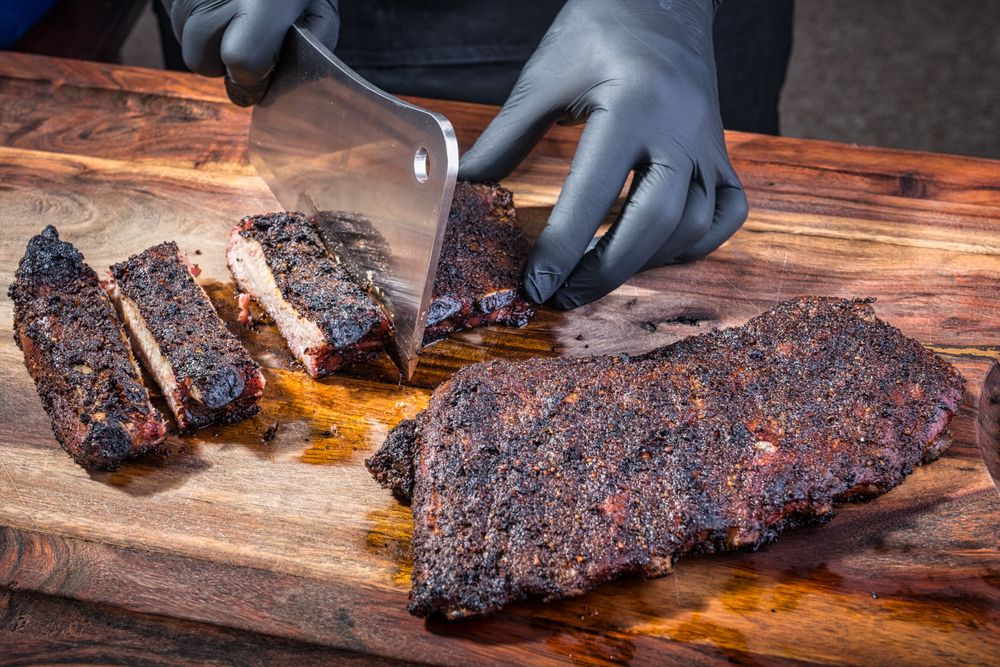A sturdy cleaver is a valuable tool in any kitchen, whether you’re dicing bulky vegetables, slicing through poultry bones, or trimming large cuts of meat. But not all cleavers are created equal—materials, weight, blade design, and handle construction can differ widely, impacting performance and comfort. If you’re looking to invest in a high-quality cleaver that will see you through many hearty meals, this guide will walk you through the key considerations. By the end, you’ll have a clearer sense of how to pick a cleaver that suits your needs, cooking style, and budget.
1. Why a Cleaver Might Be Right for You
Why It Matters
Cleavers aren’t just for professional butchers or Chinese restaurants. They can be versatile for home cooks too, excelling at tasks regular chef’s knives find challenging. A good cleaver can tackle bones or thick produce while also handling finer slicing—depending on its design.
Potential Uses
- Breaking Down Poultry: Cutting through joints, cartilage, or smaller bones.
- Chopping Hard Produce: Squash, melons, pumpkins—where weighty heft helps slice through tough rinds.
- Versatile Prep: Some thinner-bladed “Chinese-style” cleavers can be used like chef’s knives for more delicate slicing.
Takeaway
If you often work with whole chickens, large chunks of meat, or robust vegetables, a well-designed cleaver can speed up prep and minimize strain, making the investment worthwhile.
2. Different Types of Cleavers
Why It Matters
Not all cleavers are the massive, wedge-like blades you might picture. There are differences in shape, weight, and edge design, each suited to distinct tasks and cuisines.
Main Cleaver Categories
- Western Meat Cleaver
- Features: A thick, heavy blade with a straight or slightly curved edge and a pronounced rectangular shape.
- Purpose: Focused on dealing with bones and tough cartilage. Usually quite heavy, providing the power to chop without too much arm effort.
- Edge: Often not extremely sharp in the sense of fine slicing; it’s designed for brute force.
- Chinese Chef’s Cleaver (Cai Dao)
- Features: Thinner, lighter blade than a Western cleaver, with a broad surface area.
- Purpose: Multipurpose cutting—from slicing vegetables to cutting boneless meats. While sometimes referred to as a “Chinese cleaver,” it often acts more like an all-purpose chef’s knife in Chinese cuisine.
- Edge: Sharper and more refined than a heavy bone-cleaver, not meant for chopping through thick bones.
- Bone Cleaver vs. Vegetable Cleaver
- Bone Cleaver: Heavier with a thicker spine and heft, specialized for bones or cartilage.
- Vegetable Cleaver: Lighter, thinner blade for precision slicing and dicing of produce, can handle some soft boneless meats but not heavy bone-chopping.
Takeaway
Decide if you need a “chopper” for breaking bone or more of a “slicer” for produce and boneless meats. The right style of cleaver aligns with your most frequent cooking tasks.
3. Blade Material and Construction
Why It Matters
Just like other kitchen knives, cleavers come in various steels and designs. The blade’s material impacts sharpness retention, rust resistance, and how easy it is to maintain.
Common Blade Materials
- Stainless Steel: Resists rust, easier for day-to-day care, though some cheaper stainless steels may dull faster. Higher-end stainless (like German X50CrMoV15 or Japanese VG10) can balance corrosion resistance and edge retention well.
- High-Carbon Steel: Potentially super sharp and durable, but can rust or stain if not cleaned and dried promptly. Requires more upkeep.
- Carbon-Stainless Hybrid or Alloys: Some specialized steels blend the best of both worlds—sharpness + stain resistance.
Construction Tips
- Forged vs. Stamped: Forged blades often have more heft and durability, ideal for bone cleavers needing robust impact strength. Stamped can be lighter and cheaper, better for vegetable-style cleavers.
- Full Tang: Ensuring the blade’s steel extends through the handle can offer improved balance and durability, though not always a must in every design.
Takeaway
For heavy bone chopping, a forged, heavier stainless steel cleaver is typical. For more nuanced slicing with minimal rust concerns, a quality stainless or high-carbon steel blend could excel.
4. Weight, Balance, and Handle Comfort
Why It Matters
A cleaver’s weight is what allows it to power through tough cuts. However, too much heft can tire your wrist or hamper precision. Balance refers to how weight is distributed between the blade and handle, affecting control.
What to Consider
- Weight: Heavier is typically beneficial if you’re chopping through bones, so the blade does much of the work. For repeated slicing tasks, moderate weight can be better for control and less fatigue.
- Balance: Look for a balance that neither heavily favors the blade nor the handle, unless you have a personal preference. Some chefs enjoy slightly blade-forward weight for better downward chopping force.
- Handle: Should fit comfortably in your hand. Materials vary—wood, plastic, composite, or steel. Textured or contoured grips reduce slippage. Evaluate if the handle shape suits your grip style.
Takeaway
Test how a cleaver feels in your hand if possible. The right combination of weight and balance can make the difference between a joy to use or a burdensome chore.

5. Edge Profile and Sharpness
Why It Matters
Cleavers vary from thick wedge edges (for bone smashing) to narrower angles (for slicing). The edge geometry affects how the blade interacts with ingredients and how easily it can be sharpened.
Edge Nuances
- Thick, Blunt Edge: Great for primal tasks like cutting through pork ribs or chicken bones.
- Thin, Refined Edge: Slices more efficiently, requiring less force on veggies and boneless meat. However, it may chip if used on hard bone.
- Sharpening Requirements: Thicker edges can be more tolerant of rugged use but might be trickier to get truly razor-sharp. Thinner edges can achieve a finer edge but require careful technique to avoid damage.
Takeaway
If your main aim is to break bones, choose a thicker, sturdier edge. If you foresee more typical food prep with occasional cartilage, a thinner edge gives sharper slicing while still being sturdy enough for moderate tasks.
6. Brand and Price Range
Why It Matters
Cleavers can range from budget options under $30 to handcrafted artisan pieces that command several hundred dollars. While brand reputation can indicate quality, a well-reviewed midrange cleaver can often serve home cooks quite well.
Points of Reference
- Budget: $20–$50 can yield a functional, albeit potentially less refined cleaver. Great for occasional bone chopping or starting out.
- Mid-Range: $50–$100 offers a sweet spot: decent steel, comfortable handle, likely from known brands. Perfect for typical home usage.
- High-End: $100+ might be handcrafted or made from premium steels, delivering top-tier performance, aesthetics, and possibly a lifetime warranty.
Takeaway
Balance your usage frequency and budget. If you’re a heavy user or want a long-lasting, high-performing tool, investing more can pay off.
7. Maintenance and Care
Why It Matters
Well-maintained blades last longer and perform better. Cleavers, especially those used for tough tasks, can dull quickly if not cleaned and stored properly.
Maintenance Basics
- Hand Wash Only: Avoid dishwashers; they can cause warping or degrade wooden handles.
- Dry Immediately: Prevent rust, especially with high-carbon steels.
- Sharpening Schedule: Sharpen or hone your cleaver as needed—often more frequently if you chop bones.
- Storage: Use a knife block or magnetic strip to keep edges from banging into other utensils. Some heavier cleavers come with blade guards.
Takeaway
Proper cleaning, drying, and routine sharpening extends your cleaver’s life, ensuring it remains a reliable kitchen companion.
Buying the right cleaver isn’t just about brand names or fancy materials—it’s about choosing a tool that matches your culinary habits, whether you’re breaking down bones for stew or finely slicing produce for stir-fries. Start by distinguishing between heavy Western-style bone cleavers and thinner Chinese-style chef’s cleavers. Then consider factors like blade material, weight, and handle ergonomics to find a model that feels natural in your grip and stands up to your cooking tasks.
If you’re serious about repeated heavy chopping, a forged stainless steel cleaver with a thicker spine might be worth the investment. On the other hand, if you crave multi-purpose slicing convenience, a thinner, more agile cleaver can serve as a near-universal kitchen companion. Finally, remember that routine care—like handwashing, drying, and occasional sharpening—ensures that your new cleaver delivers consistent performance for years to come. With these points in mind, you’re well on your way to selecting a high-quality cleaver that fits your cooking style, budget, and culinary aspirations.


